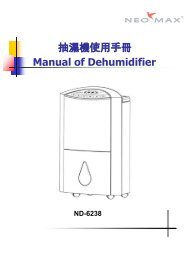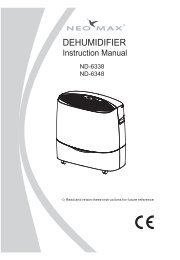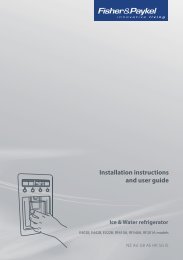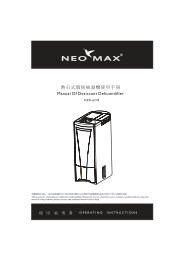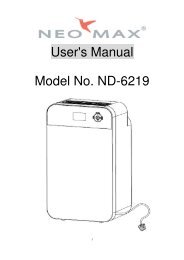Dishwasher - Kelvin Electric Trading Co., Ltd.
Dishwasher - Kelvin Electric Trading Co., Ltd.
Dishwasher - Kelvin Electric Trading Co., Ltd.
You also want an ePaper? Increase the reach of your titles
YUMPU automatically turns print PDFs into web optimized ePapers that Google loves.
<strong>Dishwasher</strong>Instruction Manual
1 Getting To Know Your MachineView of the Machine1. Upper dish basket with shelf2. Guide rail for the upper dishbasket3. Salt container4. Cutlery basket5. Detergent dispenser6. Door7. <strong>Co</strong>ntrol panel8. Filters9. Lower sprayer arm10. Lower basket11. Upper sprayer arm12. Housing (depends on the model)13. Turbo fan heat drying system(depends on the model) GB
Technical SpecificationsPermitted water pressure: 0,3 –10bar (= 3 – 100 N/cm² = 0,01-1,0Mpa)<strong>Electric</strong>al connection: 220-240 Volts,10 Amps (see type plate)Output: 1900-2200 WHeat output: 1800 WThis device corresponds to thefollowing EU directives:2006/95/EC: Low Voltage Directive2004/108/EC: EMV DirectiveDIN EN 50242: <strong>Electric</strong>al dishwasherfor home use Testing procedures forpractical service conditionsBecause we continually strive toimprove our products, we may changeour specifications and designs withoutprior notice.Note for Testing InstitutesThe necessary information forperformance testing will be providedupon request. The request can bedone by e-mail through:standard.test@blomberginternational.comPlease do not forget to write the modelcode and stock code information ofthe appliance besides your contactinformation in the e-mail. The modelcode and stock code information canbe found on the rating label, which isplaced on the side of the door.2 Safety InstructionsBefore InstallationCheck the appliance for transitdamage. Never install or use damagedmachines. If in doubt, contact yoursupplier.Before First Use• See Notes for Installation on page6.• Have the grounding systeminstalled by a qualified electrician.The manufacturer cannot be heldliable for any damage caused byoperating the appliance withoutproper grounding.• Before operating the system,please check that the informationon the type plate corresponds tothe information on your powersupply.• The dishwasher must bedisconnected from the mainsduring installation.• The appliance must not beconnected to the mains usingan extension cable. Extensioncables do not provide thenecessary safety (e.g. danger ofoverheating).• Always use the original plugdelivered with the appliance.• The plug must be freely accessibleafter the appliance has beeninstalled.Child Safety• Do not allow children to play withthe appliance.• <strong>Dishwasher</strong> detergents are causticand may cause injury to the eyes,mouth and throat. Please note thesafety instructions provided by the GB
manufacturers of the detergents.• Never leave children unsupervisedwhile the appliance is open, asthe appliance may still containdetergent leftovers.• The water in the dishwasher is notdrinking water. Danger of causticinjuries.• Always place long and sharp/pointed objects (e.g. serving forks,bread knives) into the cutlerybasket with the pointed end downor flat on the upper basket to avoidpossible injuries.For daily operation• Use your appliance only for thefollowing domestic uses: Washinghousehold dishes.• Do not use chemical solvents inthe appliance; there is a danger ofexplosion.• Do not sit or stand on the openeddoor or place other objects on it.The appliance may tip over.• Do not open the door while theappliance is running, as hot wateror steam may escape.• Do not leave the door open – anopen door can be a hazard.Problems• Repairs and modifications to theappliance may only be carriedout by qualified customer servicepersonnel.• In the event of a problem, orbefore performing a repair,disconnect the appliance from themains supply:- disconnect the appliance bypulling out the mains plug- shut off the power.• Do not pull on the cable – pull onthe plug. Turn off the water supplytap.What should not be washed inyour dishwasher• Rust sensitive steel parts• Cutlery with wooden or hornhandles• Cutlery with mother of pearl orporcelain handles• Non heat resistant plastic parts• No glued dish or cutlery parts• No items made out of copper, tinor aluminium• Sensitive decorative glasses andporcelain parts• Lead crystal glasses• Art and crafted articles• Aluminium and silver tend todiscolour• Glass and crystal articles may losetheir shine over time• Sponges and dishclothsNoteDo not wash items soiled with cigaretteash, candle wax, varnish, paints orchemicals.Recommendation:When buying new dishes, note whetherthey are suitable for the dishwasher.(marked as dishwasher proof) GB
3 Directions for AssemblySafety notes for installationPrior to installing and using yourappliance, please check it for possibletransit damage.If the appliance is damaged, pleasecontact your supplier.Never install or use a damagedappliance.The following directions must befollowed to connect the dishwasherproperly.• Before operating your dishwasher,please ensure that the informationon the type plate corresponds tothe current and voltage of yourpower supply.• The appliance may only beconnected using a properlygrounded socket. Ensure that theappliance is grounded accordingto regulations.• The grounded socket must beeasily accessible and close to theappliance.• Do not use extension cables ormultiple adapters, as this can leadto overheating, which can be a firehazard.• Hardwiring may only be carried outby a qualified electrician.• Check the power cable, thewater inlet hose and the drainagehose. Damaged parts may onlybe replaced by customer servicepersonnel or by a qualifiedelectrical service expert.Installing Your <strong>Dishwasher</strong>• Choose a suitable location for yourdishwasher. Take care to ensurethat the appliance is stable on alevel surface.• Unevenness in the floor can beequalised by adjusting the screwfeet. When the appliance isstanding correctly, the door can beclosed without difficulty.• Water inlet and drainage hosesmust be positioned so that theycan move freely without bendingor squeezing.• The appliance may not be installedin a room where the temperatureis below 0° Celsius. GB
Water connection• There are two different types ofwater inlet hoses:- <strong>Co</strong>ld water inlet hose (up to25°C)- Hot water inlet hose (up to60°C)please check which one isapplicable to your model.If you are willing to connectyour machine to naturalenergy resources or to the centralhot water supply, first check outwhether your water inlet hosetype is suitable by checking thetemperature values written on thehose. If your hose is not suitable,apply to your authorized service tochange the hose.• The dishwasher may not beconnected to open warm waterdevices or flow-through waterheaters.Permitted water pressure:Lowest permitted water pressure: 0.3bars = 3 N/cm² = 30 kPaWhen the water pressure is below 1bar, please contact your technician.Highest permitted water pressure: 10bar = 100N/cm² = 1MpaWhen the water pressure is above 10bars, a pressure reduction valve mustbe installed (available in trade supplystores).<strong>Co</strong>nnect water inlet hoseEnsure that the water inlet hose is notbent or squeezed. Do not install a usedhose set.Use a screw-on hose connector toconnect the water inlet hose to a watertap with a ¾ inch external thread. Ifrequired, use a filter insert to filterdeposits from the pipes.Check that the connection does notleak.ImportantFor safety reasons, turn off the tapafter every rinse process.1009aquAvoid plus (some models)The aquAvoid plus System protectsagainst water damage hich may becaused at the water inlet hose.Do not immerse the system’s valvebox into water; it contains electricalcomponents.In case of damage, pull out the powersupply plug.Do not shorten or lengthen the hoseinsert as it contains electrical cablesand components.2550 GB
WarningPackaging materials may bedangerous to children.Reusablesubstances may be dropped off at yourlocal disposal facilities. You may obtainfurther information from your localauthorities and disposal facilities.Used appliances –Environmental noticeThis product must notbe disposed of with yourregular household waste.Instead, you need to dispose of thewaste equipment by handing it overto a designated collection point forthe recycling of waste electricaland electronic equipment. This isindicated by a symbol to be found onthe product, it’s packaging or in themanual.Materials used are recyclableaccording to their labelling. Reuse,recycling of materials and furtherreutilization of used products areimportant contributions to protect ourenvironment.Please ask your local town council forthe nearest collection point.To avoid possible dangers, disableyour waste appliance prior todiscarding it. Pull the mains plug andcut the power cord. Disable any doorlocks.4 Using Your <strong>Dishwasher</strong>ImportantThe electricity and water connectionsof the dishwater must be in compliancewith the instructions in this booklet.Filling the dishwasher saltImportantOnly use special dishwasher salt inyour appliance.The manufacturer isnot liable for damage resulting from theuse of the wrong type of salt.salt, or any other type, these types ofsalt do not dissolve in water easily andwill damage the softening device.”Remove the lower basket from theappliance.Open the screw-in cap of the saltcontainer by turning it counterclockwise (fig. A,B).Use Diswasher salt only. Moderate orcoarse grained and easily soluble saltsare recommended. Don’t use table GB
When operating for the firsttime:Pour 1 litre of water into the saltcontainer (Fig. C).Pour the salt into the container with theaid of the salt funnel provided (Fig. D).Pour in enough salt to fill the container.The container holds approx. 2 kg.To speed up the rate of dissolution ofsalt in water, stir it with a spoon.Close the cap tightly.Begin a washing program immediatelyafter filling the salt container. Thewashing program prevents damage tothe appliance which may be caused byany spilled salt solution. After the firstwashing cycle, the salt level indicatorlight will go out.ImportantDepending on the particle sizes ofdifferent salt brands in the market,tablet properties and water hardness,dissolution of the salt in water may takea couple of hours.So, the salt indicator continues lightingfor a while after filling salt into themachine. (For models with a saltindicator)101210 GB
Filling the Rinse AidDispenserRinse aids allow washing water torinse off more cleanly and preventwatermarks or streaks on the dishes.Only use rinse aid designed for use indishwashers.NoteIf you use “2 in 1” or “3 in 1“ detergents/ tablets, you do not need an additionalrinse aid.1013Open the rinse aid dispenser bypressing the locking lever (B)Carefully pour in rinse aid to the MAXmark. Close the lid until it clicks (3).Carefully wipe off spilled rinse aid.Excessive rinse aid causes excessivefoam formation, which may hindercleaning.Set the dose of rinse aidThe dose of rinse aid to be used canbe set by means of the dispenserregulator (between levels 1 and 6) (4).Your appliance is pre-set at the factoryto level 3.Only change the setting if the followingapplies after washing:• Watermarks are visible on thedishes: Set dosage higher• Streaks are visible on the dishes:Set dosage lowerFilling the DetergentDispenserNoteOnly use detergents formulated for usein dishwashers.Open the detergent container bypushing the locking lever to the right(A).The lines on the inside of the detergentcontainer will help you measure thecorrect amount of detergent.The detergent container holds a total of40 cm³ of detergent (1).11 GB
When the dishwasher is fully loadedand the dishes are very dirty, werecommend filling the detergentcontainer up to the 25 cm³ mark. Whenthe dishes are less dirty, it is generallysufficient to fill the detergent up to the15 cm³ mark.If your dishes have been in thedishwasher for some time withoutbeing washed, you should also fill thesmall detergent container up to the line(2).The programme table shows theamounts of detergent required for thedifferent wash programmes.These may differ according to how dirtythe dishes are and the water hardnessin your location.1014DetergentPlease use detergents producedspecially for the dishwashers in yourmachine.Keep the opened detergent packagesin a cool and dry place where childrencan not reach.Put the detergent into the detergentdispenser just before operating themachine.Please contact the manufacturer toget detailed information about thedetergent you are using.Always use powder detergents inshort programs without pre-washing.Fill in the powder detergent into thecompartment nr. 2 with a grid coveras shown in the picture and close thedetergent box lid. When completelyfull, this compartment will contain 6 gof powder detergent.Do not use tablet detergents in shortprograms since the solubility of themchanges depending on the temperatureand time.In programs with pre-washing and hightemperature, in which you may usetablet detergents, make sure that thedetergent box lid is closed firmly.Excessive usage of powder detergentscan cause the detergent not dissolvecompletely and can also causescratches on the glassware.12 GB
Multipurpose DetergentsThe best washing results indishwashers is obtained by usingdetergent, rinse aid and watersoftening salt individually.New products of the detergentproducers what they call as“Multipurpose Detergent” can act aswater softening salt and/or rinse aidin addition to acting as a detergent.Some types of these detergents canalso contain special-purpose washingchemicals such as glass and stainlesssteel protectors.Multipurpose detergents commonlyfound in the market:2in1: Those contain detergent, rinseaid or water softening salt.3in1: Those contain detergent, rinseaid and water softening salt.4in1: Those containing glass protectorsin addition to detergent, rinse aid andwater softening salt.5in1: Those containing glass andstainless steel protectors in additionto detergent, rinse aid and watersoftening salt.Multipurpose detergents give satisfyingresults only under certain usageconditions. Observe the instructionsof the detergent manufacturer on thepackage when using such detergents.<strong>Co</strong>ntact the detergent producer if yourdishes are wet and/or if you notice limespots particularly on your glasses afterthe washing program is over.Make sure that salt and rinse aidcompartments are full.Set the water hardness to its highestdegree and perform an empty run.After the empty washing review theuser manual and readjust the waterhardness level so as to suit your watersupply.Make the appropriate rinse aidsettings.Depending on the model, salt indicatorand/or rinse aid indicator should beenabled again if they are disabledbefore.Loading the dishwasherGeneral:Before you load the dishwasher withdishes• Remove coarse food leftovers• Place all containers such ascups, glasses and pots into themachine with the opening facingdownwards (so that no water cancollect)• Dishes and cutlery may not beplaced above each other• Glasses may not touch• The movement of the spray armsmust not be hindered• Place all large and very dirty itemsin the lower basket.• Small and light items can go intothe upper basket.• Long and narrow items are placedin the middle of the baskets.When you give up using suchdetergents:13 GB
AttentionKnives and other utensils with sharptips and edges must be placedhorizontally into the upper basket dueto risk of injury.Please do not overload yourdishwasher and pay attention to thenotes regarding dishes which aresuited to the dishwasher.Only in this manner will you obtainoptimal washing results with a sensibleuse of energy.Suggestions for loading thedishwasherUse the lower basket for plates, bowls,pots etc.4 folding plate support rods(depending on the model)There are four separate "folding platesupport rods" in the lower basket ofyour dishwasher designed to allowyou more space to accommodatesaucepans and large bowls in thelower basket. You can either fold eachsection (1, 2, 3, 4) individually or, all atonce, to create a large empty space.Simply press the handgrips (A) andfold them down"1017101514 GB
2 folding plate support rods(depending on the model)There are two separate "folding platesupport rods" in the lower basket ofyour dishwasher designed to allowyou more space to accommodatesaucepans and large bowls in thelower basket. You can either fold eachsection (1, 2) individually or, all at once,to create a large empty space.Simply press the handgrips (A) andfold them down"1054Bottle holder(depends on some models)For cleaning your bottles. To remove,pull the holders apart in oppositedirections (H).102015 GB
Variable cutlery basket(depending on the model)The variable cutlery basket can beseparated into 3 parts depending onthe amount of cutlery and the degreeof dirtiness.Small cutlery basket sections also fitinto the upper basket.To do this, turn the lock on the handleto the right (A).Pull the smaller cutlery basket upwardsand out of its holders (B).To put the parts together again,proceed in the opposite direction.Use the basket inset (C) for yourcutlery so that all items in the basketare surrounded by a sufficient waterflow.For larger items (e.g. wire whisks), thebasket inset may be removed (C).To make loading easier, the cutlerybasket can be removed.1030Place long items such as ladles,cooking spoons etc. on the rack in theupper basket.16 GB
Basket insert with variable heightsettings(depending on some models)You can also use this insert in thelower basket for glasses and longhandledcutlery / utensils.If you do not need the insert, fold therack upwards at the angle shown (A).Push the entire insert upwards (B).Place the insert in the upright position(C). Push the insert downwards andlock it into place with the holder (D).1019When you want to use the basketagain, reverse the procedure.To set the height, push the rackupwards and fold it open in position(G).When finished, check that the sprayerarm can still move freely.17 GB
Loading suggestionsLoad the upper basket with dessertplates, cups, glasses etc.1027Upper basket with variable heightsetting(depends on some models)The upper basket is equipped with alifting mechanism which enables youto change the height of the basketwithout having to remove it from thedishwasher, even if it is fully loaded.1021The height of the upper basket wasset to its lowest position at the factory.To lift the upper basket to the “high”(A) position, hold it on one side andcarefully pull it upwards. To lift theopposite side of the basket, hold it andpull it upwards in the same manner (A).To lower the upper basket, hold thebasket lever on one side and carefullylower the basket without releasing thelever (B). Repeat the procedure withthe lever on the opposite side of thebasket. Make sure that both leverscatch at the same height.18 GB
Height setting with empty basket(depends on the model)In this model, the height setting of theupper basket may be changed usingthe wheels which are mounted at twodifferent heights.Release the latches on both the rightand left tracks of the upper basket bypushing them outwards (C).Pull out the basket out completely (D).Place the basket back into the tracks atthe desired height (E).Push the latches back into the correctposition.1022Rack(depends on the model)Depending on the size of the glassesand cups, the rack height setting maybe adjusted (C, D, E).102319 GB
Glass Support(depends on the model)When placing the glasses or gobletswith a long grip, lean them against theglass support, the edge of the basketor the shelf but not against the otherpieces. Do not lean the long glassesagainst each other, otherwise they donot remain stable during washing cycleand may get damaged.1025When you need to place the bulkypieces into the upper basket,disconnect the lug of the glass supportfrom the bar of the basket where it isattached to. Thus, you will acquire awider place.Upper Basket Drawer(depends on the model)You can easily place additional desertspoons, small forks and knives into thedrawer installed to the upper basket ofyour machine.102620 GB
5 How to clean your dishwasherCleaning your machine at regularintervals ensures longer product lifeand reduces the risk of reccurringproblems.WarningAlways unplug the machine and turnoff the water supply before cleaning.Use a gentle household cleaner for theoutside and the door seals. Clean thecontrol panel only with a moist clothand clear water.Cleaning the filtersClean the filters and the spray armsregularly. A dirty machine will have anegative effect on the cleaning results.WarningDo not operate your dishwasherwithout a filter. Ensure that your filtersare correctly installed. Clean the filtersregularly.10311. Main filter2. <strong>Co</strong>arse filter3. Micro filter1. Remove the lower basket from themachine.2. Turn the coarse filter to the rightand pull it out in an upwarddirection (A).3. Pull out the main filter (B).4. Press on the two tongues of thecoarse filter and remove the microfilter (C).5. Clean the filters thoroughly underrunning water. Use a brush ifnecessary.6. Replace main fitler.7. Replace the micro filter and thecoarse filter into the main filter.Twist it clockwise until it clicks in.21 GB
Cleaning the spray armsDirt or calcium residue may block thenozzles on the spray arms. For thisreason, regularly check the spraynozzles.1. Lower spray arm2. Upper spray arm1. Remove the lower basket from themachine.2. Pull off the lower spray arm in anupward direction (A).3. Loosen the fastening screw of theupper spray arm and pull off thespray arm (B).4. Clean the spray arms underrunning water.5. Replace the spray arms.Cleaning the filter inset in the waterinlet hose (depending on the model)Dirt from deposits in the water pipes isprevented by a filter in the water inlethose. Check the filter and the waterinlet from time to time.1. Close the water tap and unscrewthe water inlet hose.2. Take out the filter and clean itunder running water.3. Replace the cleaned filter.4. Fasten the water inlet hose to thewater tap again.WarningEnsure that the fastening screws arescrewed tight.103222 GB
6Troubleshooting:What to do if the dishwasher will not run• Check that the mains plug is properly connected.• Are all fuses working?• Is the water supply fully turned on?• Is the dishwasher door closed firmly?• Have you pressed the On/Off button?• Is the filter on the water intake and dishwasher clogged?The cleaning results are unsatisfactory1033Uncleaned DishesDisorderly placement- Load your dishes as described in the manual.Program selection- For products with program selecting feature, choose a longer program thatwashes in higher temperatures.Blocked impellers- Prior to starting the program, ensure by turning by hand that the upper andlower impellers are freely rotating.Clogged filters- From time to time, remove the complete filter system as shown in the manualand wash it under flowing water.Misplaced or displaced filters- After washing the filter system, replace them as shown in the manual.Clogged impeller holes- Take out and clean the impellers from time to time as shown in the figure.Overloading the baskets- Do not overload the baskets in excess of their capacityDetergent kept under unsuitable conditions- If you are using powder detergents, do not store them in humid places afteryou open their boxes. Keep them in a closed container, if possible. For easeof-storing,we recommend you to use tablet detergents.Inadequate detergent- If you are using powder detergents, adjust the amount of detergentaccording to the soiling degree of your dishes and/or program definitions. Werecommend you to use tablet detergents for optimum results.23 GB
Inadequate rinse aid- Increase rinse aid setting or add rinse aid into rinse aid compartment.Unsealed detergent dispenser lid- Always ensure that the detergent compartment lid is closed tightly after everydetergent filling process.DryingDisorderly placement- Load your dishes as described in the manual.Inadequate rinse aid- Increase rinse aid setting or add rinse aid into rinse aid compartment.Unloading the machine right after dishwashing- Do not unload your dishwasher right after washing process is completed.Slightly open the door and wait for evacuation of the inside steam for a while.Unload the dishes after the pieces cool down to a touchable level. Startunloading process from the lower basket.Program Selection- For products with program selecting feature, choose a longer program thatwashes in higher temperatures.1034Tea, <strong>Co</strong>ffee And Lipstick StainsProgram Selection- For products with program selecting feature, choose a longer program thatwashes in higher temperatures.Detergent kept under unsuitable conditions- If you are using powder detergents, do not store them in humid places afteryou open their boxes. Keep them in a closed container, if possible.- For ease-of-storing, we recommend you to use tablet detergents.Usage of silverware-kitchenware with corrupted surface quality- Silverware or kitchenware with corrupted surface quality should not bewashed in dishwashers.24 GB
1035Lime Stains, Hazy LookInadequate rinse aid- Increase rinse aid setting or add rinse aid into rinse aid compartment.Insufficient water softening- In products equipped with water softening setting, water softening should beproperly set in accordance with the hardness of the supply water. Add saltinto the salt container, if necessary.Salt leakage*- Use the supplied salt funnel while filling in softening salt. Make sure thatthe salt box cover is tightly closed after finishing the filling process. Run awashing program to clean up the salts spilled in the machine. Recheck thesalt box cover after the program is completed.Metallic Look In Bluish Rainbow <strong>Co</strong>lorExcessive rinse aid- Lower rinse aid setting.1036Hazy, Milky-Dish Look And Bluish / Rainbow<strong>Co</strong>lor Appearance In Glassware When TheyAre Hold Against LightGlass corrosion due to soft water- In products equipped with water softening setting, water softening shouldbe properly set in accordance with the hardness of the supply water. If yoursupply water is soft (
1041Scratch / Break In GlasswareKitchenware containing Aluminum- Kitchenware that contains aluminum should not be washed in dishwashers.Salt leakage*- Use the supplied salt funnel while filling in softening salt. Make sure thatthe salt box cover is tightly closed after finishing the filling process. Run awashing program to clean up the salts spilled in the machine. Recheck thesalt box cover after the program is completed.Low water softening setting, inadequate salt*- In products equipped with water softening setting, water softening should beproperly set in accordance with the hardness of the supply water. Add saltinto the salt container, if necessary.Detergent kept under unsuitable conditions- If you are using powder detergents, do not store them in humid places afteryou open their boxes. Keep them in a closed container, if possible. For easeof-storing,we recommend you to use tablet detergents.Overloading the baskets- In order to avoid scratches and breaks in glasses and other glass tablewarebecause of collision with each other during washing process arising from theirplacement, do not overload the baskets in excess of their capacity.1037Rusts, Blackening And <strong>Co</strong>rruption Of SurfaceUnsealed closing of the salt box cover*- Salt may cause oxidation on metal surfaces. Use the supplied salt funnelwhile filling in softening salt. Make sure that the salt box cover is tightlyclosed after finishing the filling process. Run a washing program to clean upthe salts spilled in the machine. Recheck the salt box cover after the programis completed.Grounding line- Check if your dishwasher is connected to the actual grounding line.Otherwise, the static electric created in the dishwasher may remove theprotective coating on metal surfaces and cause blackening and corruption.26 GB
1038Detergent Remains In The DetergentDispenserDamp detergent compartment- Make sure that the detergent dispenser is well dried prior to filling it withdetergent.Putting detergent in the detergent dispenser long before washing- Take care that detergent is put shortly before startup of washing.Preventing opening of detergent dispenser lid during washing- Ensure that the lid of detergent dispenser is not opened during loading thedishes so that entering of water from the impellers into it is prevented.Detergent kept under unsuitable conditions- If you are using powder detergents, do not store them in humid places afteryou open their boxes. Keep them in a closed container, if possible. For easeof-storing,we recommend you to use tablet detergents.Clogged impeller holes- Take out and clean the impellers from time to time as shown in the figure.1043Water Remained In The Dishwashing<strong>Co</strong>mpartment After WashingClogged filters- From time to time, remove the complete filter system as shown in the manualand wash it under flowing water.Blocking / twisting of drainage hose- <strong>Co</strong>nnect the drainage hose as described in the manual.OdourOdor of new dishwasher- A new dishwasher has a peculiar odor. It will fade out after a couple ofwashing.Clogged filters- From time to time, remove the complete filter system as shown in the manualand wash it under flowing water.Leaving the dishes in the dishwasher for a long time- If you are not going to run your dishwasher immediately, load the dishes into27 GB
your machine after scraping the excessive soil on them and do not tightlyclose the door of the machine. Every other day, perform washing withoutdetergent in the shortest program for products with program selecting feature.1042FoamLoading the dishes into the dishwasher without completely drying afterwashing them with hand-wash detergent.- Hand-wash detergents do not contain antifoam. There is no need to handwashthe dishes with detergent before loading the dishes into the machine.Scraping the coarse soil on the surfaces with a tissue paper or fork will besufficient.Spilling rinse aid in the machine while filling- Take care that rinse aid is not spilled in the machine when you are filling it.Clean any spilled amount with the help of a tissue paper/towel.Leaving the rinse aid lid open or not closing it- Rinse aid compartment should always be closed as shown in the manualafter it is filled with rinse aid.1039Usage of decorated glasses and porcelains- Decorated glasses and decorated luster porcelains are not suitable fordishwasher washing. Manufacturers of glassware and porcelain tablewareitems do not recommend washing these items in the dishwashers either.*: In products with a salt containerErasing Of DecorationsServiceIf your appliance ever malfunctions, check the notes and advice given in theoperating manual.If this does not fix the problem, our customer service staff are available to assistyou.28 GB
GB 17 1388 0100-06




